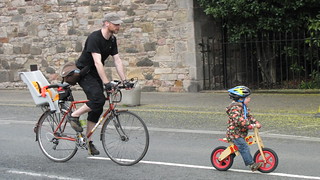The draft response from Spokes goes as follows. (I think they said that the final version may be trimmed a bit, but essentially this is it).
17/00168/FUL Residential Development, Quartermile
Objection from Spokes, the Lothians Cycle Campaign
1 General
In general we support developments of this kind. It comprises a re-use of 'brownfield' land; it is located in the City Centre, with excellent access to all amenities, thus reducing the need to travel (the prime objective of travel sustainability), and with excellent access to public transport as well as to local walking and cycle routes, all of which should encourage healthy lifestyles for the residents, and minimal car use.
It is therefore deeply disappointing that the developers have taken almost no notice of our comments from the PAN exhibition, and made no concessions, even though what we asked is do-able and affordable.
2 The PAC Report
There were only 6 comments left at the public exhibition, and three of these related to cycling. Below, we repeat the original comments (regular typeface, size 10), followed by the developer response (italics), followed by our response to these (regular, size 12):
2.1
What is needed is good cycle access to
the western side of the Bryce Building or
its southern side. The present street
(Porter’s Walk) is marked “Cyclists
Dismount”, and is too narrow for shared
use. If it could be wider it could be useful
for cycling.
Access for all, including cyclists, has always
formed an important part of the wider
master plan.
This is clearly not true. If cycle access had 'always formed an important part of the Master-plan', how is it that 'Cyclists Dismount' signage is now planned? 'Dismount' signage is an indication of poor planning. We have suggested remedies - use as much of the open space as possible, via signage and markings - but this has been rejected
2.2
Another limiting factor is that Nightingale
Way is one-way westwards. Can it be
made 2-way for cyclists (in line with council
policy for new 1-way streets)?
Careful cyclists are welcome to pass through
the Quartermile site, but pedestrian safety
remains a priority. This may require cyclists to
dismount when moving through some areas of
the Quartermile site.
This response does not address the objection. It is still possible to achieve a counter-flow for cyclists along Nightingale Way, without impinging at all on pedestrian safety.
2.3
I was interested that you’d had several
visitors mentioning cycling.
Indeed. There were 6 comments left at the PAN. Three of these, ie 50%, related to cycling. The developers' negative responses to our suggestions are thus very disappointing.
We’d like to suggest that the east-west
shared-use path which runs along the
south side of our site should be widened,
along the length of the site, to about 4m. It
is obviously a well-used route, and the
widening, by a metre or so, would ease
congestion, while at the same time causing
little disruption at the ends where the path
would narrow again.
Noted. This would be difficult to achieve,
given the established pattern of development
across the site, including the spaces between
the buildings.
This is a mendacious reply. The widening could be achieved by signage (and markings on the pavement) and would not be at all difficult.
2.4
Routes around your building, and through
the middle of the site, will clearly be well-
used for off-road access to the medical
facility to the north (in the original part of
the site), and we hope suitable cycle
parking will be provided near the facility.
There will be suitable cycle parking provided
as part of the application proposals.
Response misses the point. The main point being made is about the off-road routes TO the other building, not cycle parking.
2.5
My main comment is that Porter’s Way
needs to be opened for shared use
cycling. The City of Edinburgh and the
University are both keen to support
cycling, and this is a simple way to do so. It
is absurd that Quartermile, immediately
adjacent to the excellent cycle route on
Middle Meadow Walk, is so impermeable
to cycles.
The Quartermile development has always
welcomed cyclists. However, in order to
ensure pedestrian safety across the site,
cyclists are asked to dismount and walk for
short sections only.
'Cyclists Dismount' is a sign of bad planning. Pedestrian and cycle safety can be achieved in a more welcoming way, for example by 'shared use' signage, or 'cyclists beware pedestrians', or even 'cyclists beware pedestrians beware cyclists' (with text laid out in 5 lines).
3 Our objections
We have three basic objections:
3.1 Procedural
The developers have responded to our comments from the PAN but have made no effort to meet our reasonable needs - see above. Where the Master Plan has not been adhered to, resulting in insufficient widths between buildings, for example, to allow shared for pedestrians and cyclists) every effort should be made at this stage to compensate for the deficiencies. We have pointed out that this can be done at fairly small cost.
3.2 One-way streets
City of Edinburgh Council has a policy that any new one-way streets should have a contraflow for cyclists:
PCycle3 : There will be a presumption that all streets will be two way. However, if
new one-way streets have to be implemented to manage motor traffic, there will be
a presumption that cyclists will be exempted from the one-way restriction. (LTS, 9.2, p.45)
Here, both the main roads through the site - Nightingale Way and Simpson Loan - are one-way westwards, so cyclists coming from the south-west along North Meadow Walk (the main "cyclist highway" in the plans) cannot get to the carefully-placed cycle racks in the new development without walking along either street, or taking a long detour via Middle Meadow Walk, or an even longer and hilly detour crossing Lauriston Place twice.
The same problem will be met by cyclists wanting to reach the proposed Business School in the old Surgical Building.
Nightingale Way at least, and preferably both, MUST be made two-way for cyclists. There is plenty of room for a contraflow lane. Costs of making these changes would be small, since no engineering would be involved.
3.3 'Cyclists Dismount” signage
While there is no specific mention of this in the LTS, the Council itself does not use it, and it goes against the spirit of Council policy, which is to support and encourage cycling. The developers have given no objective evidence in support of usage; and their claimed objective of 'pedestrian safety' can be achieved in a more cycle-friendly way, for example with signs like 'cyclists beware pedestrians' (and vice versa).
The need for such signage should never have arisen in the first place. If the site had been well designed, enough space would have been left (in Porters' Way, for example) to accommodate both modes with less risk of conflict. 'Cyclists Dismount' is thus a marker of bad design.
We suggest instead that a more cycle-friendly signage be used.
In the Netherlands, by comparison, the equivalent sign (fietsers afstappen) is very difficult to find at all. The blog below from a cyclist who knows both countries illustrates the differences - and ridicules us:
'Cyclists Dismount' Blog: compares Netherlands with Britain
Two years ago I blogged about the relative absense of such signs on the Dutch cycle path network. On the Study Tour Back in 2006 I offered €10 to the first person in our group from the UK who saw one of these signs, knowing that even though we were going to places I'd never been before I had very little chance of losing my money (and yes, I kept my money).
I've now lived in the Netherlands for nearly three years and cycled tens of thousands of kilometres in that time. I know that there are other Fietsers Afstappen signs, as occasionally Dutch people email me their photos of such signs. Often this is accompanied by text describing how "terrible" it is. However, this [photo] remains the only permanently mounted "Fietsers Afstappen" sign that I've ever seen with my own eyes.
In Britain, "Cyclists Dismount" signs are a ludicrously frequent feature of cycle facilities. I once started to make a web page showing all such signs in Cambridge, but gave up when I realised how much time this was going to take...
I still think "dismount" signs, all of them, are a blot on the cycling landscape. However, when they are as uncommon as this they make practically no difference at all to cyclists. ... There are various initiatives in the Netherlands to identify bad cycle facilities and have the problems caused by them addressed. This is one of them.
4 Design Award
It's worth noting that if ever Quartermile were put up for a design award, the presence of Cyclists Dismount signs and the contravention of a CEC Policy (PCycle 3) in the development would most probably count against them.
We therefore urge the developers to take the fairly simple measures we have suggested to make the proposals conform with CEC policy and intent.
Yours etc,
Peter Hawkins
Spokes Planning Group

 posts
posts
